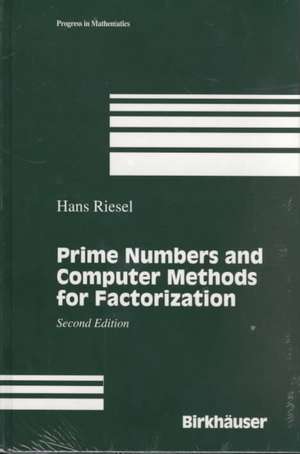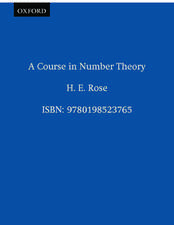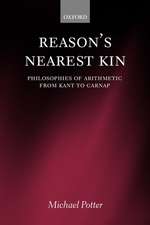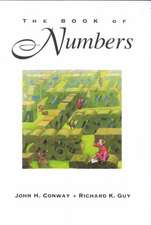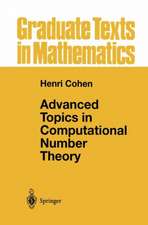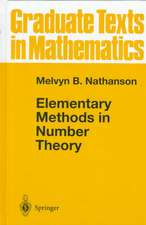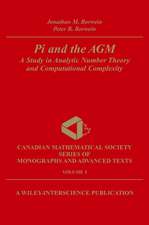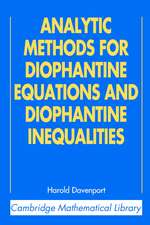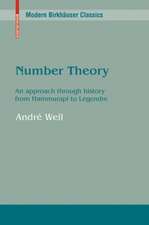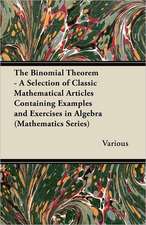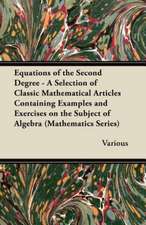Prime Numbers and Computer Methods for Factorization
Autor Hans Rieselen Limba Engleză Hardback – oct 1994
| Toate formatele și edițiile | Preț | Express |
|---|---|---|
| Paperback (2) | 536.63 lei 6-8 săpt. | |
| Birkhäuser Boston – 22 noi 2011 | 536.63 lei 6-8 săpt. | |
| Birkhäuser Boston – 30 sep 2012 | 593.08 lei 6-8 săpt. | |
| Hardback (1) | 600.87 lei 6-8 săpt. | |
| SPRINGER NATURE – oct 1994 | 600.87 lei 6-8 săpt. |
Preț: 600.87 lei
Preț vechi: 706.91 lei
-15% Nou
Puncte Express: 901
Preț estimativ în valută:
115.01€ • 124.97$ • 96.67£
115.01€ • 124.97$ • 96.67£
Carte tipărită la comandă
Livrare economică 21 aprilie-05 mai
Preluare comenzi: 021 569.72.76
Specificații
ISBN-13: 9780817637439
ISBN-10: 0817637435
Pagini: 484
Dimensiuni: 160 x 241 x 32 mm
Greutate: 0.89 kg
Ediția:2nd edition
Editura: SPRINGER NATURE
Locul publicării:Boston, MA, United States
ISBN-10: 0817637435
Pagini: 484
Dimensiuni: 160 x 241 x 32 mm
Greutate: 0.89 kg
Ediția:2nd edition
Editura: SPRINGER NATURE
Locul publicării:Boston, MA, United States
Public țintă
ResearchCuprins
Preface.-The Number of Primes Below a Given Limit.-The Primes Viewed at Large.-Subtleties in the Distribution of Primes.-The Recognition of Primes.-Classical Methods of Factorization.-Modern Factorization Methods.-Prime Numbers and Cryptography.-Appendix 1. Basic Concepts in Higher Algebra.-Appendix 2. Basic concepts in Higher Arithmetic.-Appendix 3. Quadratic Residues.-Appendix 4. The Arithmetic of Quadratic Fields.-Appendix 5. Higher Algebraic Number Fields.-Appendix 6. Algebraic Factors.-Appendix 7. Elliptic Curves.-Appendix 8. Continued Fractions.-Appendix 9. Multiple-Precision Arithmetic.-Appendix 10. Fast Multiplication of Large Integers.-Appendix 11. The Stieltjes Integral.-Tables.-List of Textbooks.-Index.
Recenzii
"Here is an outstanding technical monograph on recursive number theory and its numerous automated techniques. It successfully passes a critical milestone not allowed to many books, viz., a second edition. Many good things have happened to computational number theory during the ten years since the first edition appeared and the author includes their highlights in great depth. Several major sections have been rewritten and totally new sections have been added. The new material includes advances on applications of the elliptic curve method, uses of the number field sieve, and two new appendices on the basics of higher algebraic number fields and elliptic curves. Further, the table of prime factors of Fermat numbers has been significantly up-dated. ...Several other tables have been added so as to provide data to look for large prime factors of certain 'generalized' Fermat numbers, while several other tables on special numbers were simply deleted in the second edition. Still one can make several perplexing assertions or challenges: (1) prove that F\sb 5, F\sb 6, F\sb 7, F\sb 8 are the only four consecutive Fermat numbers which are bi-composite; (2) Show that F\sb{14} is bi- composite. (This accounts for the difficulty in finding a prime factor for it.) (3) What is the smallest Fermat quadri-composite?; and (4) Does there exist a Fermat number with an arbitrarily prescribed number of prime factors? All in all, this handy volume continues to be an attractive combination of number-theoretic precision, practicality, and theory with a rich blend of computer science." ߝZentralblatt Math
"Here is an outstanding technical monograph on recursive number theory and its numerous automated techniques. It successfully passes a critical milestone not allowed to many books, viz., a second edition. Many good things have happened to computational number theory during the ten years since the first edition appeared and the author includes their highlights in great depth. Several major sections have been rewritten and totally new sections have been added. The new material includes advances on applications of the elliptic curve method, uses of the number field sieve, and two new appendices on the basics of higher algebraic number fields and elliptic curves. Further, the table of prime factors of Fermat numbers has been significantly up-dated. ...Several other tables have been added so as to provide data to look for large prime factors of certain 'generalized' Fermat numbers, while several other tables on special numbers were simply deleted in the second edition. Still one can make several perplexing assertions or challenges: (1) prove that F\sb 5, F\sb 6, F\sb 7, F\sb 8 are the only four consecutive Fermat numbers which are bi-composite; (2) Show that F\sb{14} is bi- composite. (This accounts for the difficulty in finding a prime factor for it.) (3) What is the smallest Fermat quadri-composite?; and (4) Does there exist a Fermat number with an arbitrarily prescribed number of prime factors? All in all, this handy volume continues to be an attractive combination of number-theoretic precision, practicality, and theory with a rich blend of computer science." -Zentralblatt Math
"Here is an outstanding technical monograph on recursive number theory and its numerous automated techniques. It successfully passes a critical milestone not allowed to many books, viz., a second edition. Many good things have happened to computational number theory during the ten years since the first edition appeared and the author includes their highlights in great depth. Several major sections have been rewritten and totally new sections have been added. The new material includes advances on applications of the elliptic curve method, uses of the number field sieve, and two new appendices on the basics of higher algebraic number fields and elliptic curves. Further, the table of prime factors of Fermat numbers has been significantly up-dated. ...Several other tables have been added so as to provide data to look for large prime factors of certain 'generalized' Fermat numbers, while several other tables on special numbers were simply deleted in the second edition. Still one can make several perplexing assertions or challenges: (1) prove that F\sb 5, F\sb 6, F\sb 7, F\sb 8 are the only four consecutive Fermat numbers which are bi-composite; (2) Show that F\sb{14} is bi- composite. (This accounts for the difficulty in finding a prime factor for it.) (3) What is the smallest Fermat quadri-composite?; and (4) Does there exist a Fermat number with an arbitrarily prescribed number of prime factors? All in all, this handy volume continues to be an attractive combination of number-theoretic precision, practicality, and theory with a rich blend of computer science." -Zentralblatt Math
Textul de pe ultima copertă
In the modern age of almost universal computer usage, practically every individual in a technologically developed society has routine access to the most up-to-date cryptographic technology that exists, the so-called RSA public-key cryptosystem. A major component of this system is the factorization of large numbers into their primes. Thus an ancient number-theory concept now plays a crucial role in communication among millions of people who may have little or no knowledge of even elementary mathematics.Hans Riesel’s highly successful first edition of this book has now been enlarged and updated with the goal of satisfying the needs of researchers, students, practitioners of cryptography, and non-scientific readers with a mathematical inclination. It includes important advances in computational prime number theory and in factorization as well as re-computed and enlarged tables, accompanied by new tables reflecting current research by both the author and his coworkers and by independent researchers.The book treats four fundamental problems: the number of primes below a given limit, the approximate number of primes, the recognition of primes and the factorization of large numbers. The author provides explicit algorithms and computer programs, and has attempted to discuss as many of the classically important results as possible, as well as the most recent discoveries. The programs include are written in PASCAL to allow readers to translate the programs into the language of their own computers.The independent structure of each chapter of the book makes it highly readable for a wide variety of mathematicians, students of applied number theory, and others interested in both study and research in number theory and cryptography.
Caracteristici
Affordable reprint of the successful, expanded second edition of a unique monograph Provides a unique perspective on the study of prime numbers and their importance in modern technology Applications remain relevant across the fields of modern computer science and information transmission Includes supplementary material: sn.pub/extras
